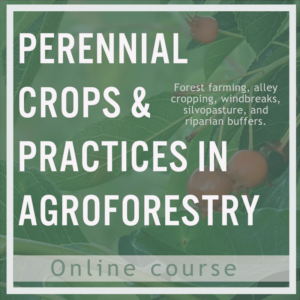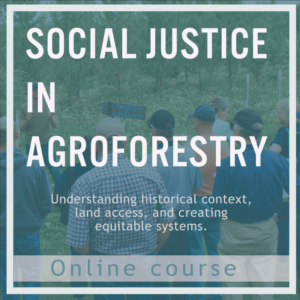Managing Agroforestry Systems in a Changing Climate
$40.00
All ecosystems are complex, including agroforestry systems. They are made up of many organisms interacting with each other and their environment. Through observing and understanding how ecosystems function, people can work with natural processes to design and manipulate ecosystems for desired benefits in ways that are sustainable, resilient, and even regenerative. In this course, we dive into these fundamentals of agroforestry management. In Lesson 1, we discuss how biodiversity is essential to agroforestry systems and ways that practitioners maintain biodiversity in agroforestry systems. In Lesson 2, we explore how climate change is affecting agricultural ecosystems and how agroforestry can contribute to climate change adaptation and mitigation.
Out of stock
All ecosystems are complex, including agroforestry systems. They are made up of many organisms interacting with each other and their environment. Through observing and understanding how ecosystems function, people can work with natural processes to design and manipulate ecosystems for desired benefits in ways that are sustainable, resilient, and even regenerative. In this course, we dive into these fundamentals of agroforestry management. In Lesson 1, we discuss how biodiversity is essential to agroforestry systems and ways that practitioners maintain biodiversity in agroforestry systems. In Lesson 2, we explore how climate change is affecting agricultural ecosystems and how agroforestry can contribute to climate change adaptation and mitigation.
- Introduction
- Module Overview
- Essential Questions
- Learning Objectives and Content Topics
- Lesson 1: Ecology of Agroforestry Systems
- Farmer Voices
- Thinking in systems
- Mimicking nature
- The importance of biodiversity in agroforestry systems
- Biodiversity is essential for producing ecosystem services
- Biodiversity is essential for sustainability and resilience
- How do practitioners maintain biodiversity in agroforestry systems?
- Select plants for complementarity
- Create disturbances to initiate ecological succession
- Manage trade-offs between diversity and efficiency
- Cover soil perennially to maintain soil fertility
- Create habitat to manage pests and diseases
- Iteratively experiment, observe, learn, and adapt management practices
- Reflection Questions
- Summary
- Supplemental Resources
- Lesson 2: Agroecological Considerations of Climate Change
- Farmer Voices
- What causes climate change?
- How is climate change affecting agriculture?
- How can agroforestry contribute to climate change mitigation?
- How can agroforestry contribute to climate change adaptation?
- Supplemental Resources
Who should take this course? Those new to agroforestry, beginners, and dreamers. Throughout the course, we purposefully refer to people as agroforesters, practitioners, stewards etc., recognizing that not all people interested in beginning agroforestry projects identify as a farmer. Additionally, agroforestry projects can get started in rural and urban locations and everywhere in between. We also welcome those wanting to learn more about agroforestry in order to teach others the benefits of agroforestry. Regardless, whether you’re looking to diversify your income or landscape, or to help and strengthen your community, agroforestry has a lot to offer.
So let’s get started!






